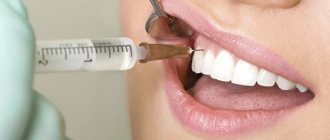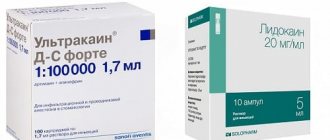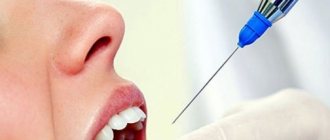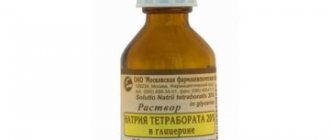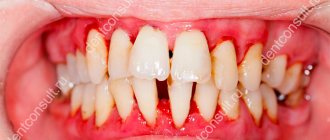From this article you will learn:
- reviews on Ultracain, release forms,
- pros and cons of the drug,
- How much does Ultracaine anesthesia cost?
The article was written by a dental surgeon with more than 19 years of experience.
The anesthetic Ultracaine is a drug in the form of an injection solution that has a very high analgesic effect when administered locally into tissues. The main active component of ultracaine is the substance “articaine hydrochloride” (Articaine), which makes it possible to classify this drug as an anesthetic of the articaine series. Ultracaine is most often used in dentistry, which is explained by its high efficiency.
There are several forms of release of this drug, which differ from each other in the concentration of the vasoconstrictor component (epinephrine) included in ultracaine. It is added to articaine to locally reduce blood supply in the anesthesia zone and reduce the leaching of the anesthetic from the tissues. Those. Epinephrine increases the duration and depth (strength) of anesthesia.
Anesthetic Ultracaine and carpule syringe –
For dentistry, the anesthetic is available both in the form of regular injection ampoules and special cartridges called carpules (these are most often used). The anesthetic carpule is inserted inside a special carpule syringe, which has a piston in the form of a handle, and a special double-edged needle is inserted into it from the side of the syringe nose. When pressing on the syringe piston, the latter presses on the movable rubber liner inside the carpule, which leads to an increase in pressure inside the carpule and the release of the anesthetic solution through the needle.
Ultracaine release forms –
- ultracaine DS-forte (epinephrine concentration 1:100,000),
- ultracaine DS (epinephrine concentration 1:200,000),
- ultracaine D (without epinephrine).
The presence of three forms of drugs is explained by the possible side effects of epinephrine, which can increase the patient's blood pressure. For completely healthy people who do not have cardiovascular or other diseases, Ultracain DS Forte is used. For moderately high blood pressure, Ultracaine DS with a reduced concentration of epinephrine can be used. However, the instructions for use for Ultracain indicate that any of the listed forms can be used from the age of 4 years. We will tell you more about the indications for use of each form below.
How anesthesia is performed in dentistry: video
Ultracaine: price of anesthesia
The cost of 1 carpule of Ultracaine is from 90 rubles (this is the price at which dental clinics purchase it). But in a dental clinic using Ultracain, the price for anesthesia will be approximately 400 to 500 rubles. Unfortunately, you won’t be able to buy a carpule of anesthetic at a pharmacy and bring it with you. This is strictly prohibited by law, because... In this case, the dentist cannot guarantee that the anesthetic is not counterfeit or that it was stored correctly. As a result, the dentist will in any case be to blame for the complications and will be held responsible for it.
Equipment
Essentially, a carpule syringe is a metal dental anesthesia syringe that can be used many times and is sterilized in the same way as other dental instruments. A carpule with an anesthetic is inserted into the carpule syringe - a special glass cartridge, factory-made.
Currently, the Trilogy Medical and Dental Center uses carpule syringes for injection anesthesia - they are much more convenient and more sophisticated than conventional disposable syringes.
Forms of release of the anesthetic Ultracaine -
Ultracaine: the composition, regardless of the release form, 1 carpool of anesthetic contains the anesthetic articaine 40 mg, and the volume of anesthetic solution in the carpul will be 1.7 ml. As for the content of epinephrine, as we said above, each of the three forms will have its own concentration of this vasoconstrictor component (vasoconstrictor). It should also be noted that ultracaine anesthetic contains the preservative sodium disulfite, which is designed to stabilize epinephrine in the drug. Moreover, since Ultracain D is produced without epinephrine, it will not contain preservatives.
Ultracaine DS forte (epinephrine 1:100.000) –
An excellent anesthetic for achieving a pronounced and long-lasting analgesic effect during surgical interventions in the oral cavity, for depulping teeth, etc. However, this form cannot be used for high blood pressure, severe cardiovascular diseases, thyroid disease and bronchial asthma.
For detailed instructions from the manufacturer, read: → Ultracain DS forte – instructions for use (PDF)
Ultracaine DS (epinephrine 1:200.000) –
The best option for use in patients at risk - pregnant and lactating women, patients with compensated cardiovascular diseases. It is undesirable to use for bronchial asthma. Cannot be used for thyroid diseases.
For detailed instructions from the manufacturer, read: → Ultracain DS – instructions for use (PDF)
Ultracaine D (without epinephrine) –
The optimal choice if there is a high risk of allergic reactions, because... This anesthetic is completely free of any preservatives that are necessary to stabilize anesthetics containing adrenaline. In this regard, it is a good choice also for patients with bronchial asthma. Due to the absence of adrenaline, it can be used for diseases of the thyroid gland. The absence of adrenaline allows its use in patients with severe cardiovascular disorders, but it must be taken into account that the duration of action of the anesthetic without epinephrine/adrenaline will be no more than 20 minutes.
For detailed instructions from the manufacturer, read: → Ultracain D – instructions for use (PDF)
Features of pain relief in pregnant women
One of the most common misconceptions is that pregnant women are contraindicated for dental treatment. You should not trust unreliable sources; dentistry and pregnancy are completely compatible concepts. Expectant mothers should undergo a professional examination during planning and at 8, 18 and 28 weeks of pregnancy. Untreated infections in the oral cavity contribute to the development of other dangerous diseases.
The question immediately arises: can the use of dental anesthesia harm the health of the unborn child? Modern technologies allow the use of drugs with lower concentrations of adrenaline. Accepted painkillers are ultracaine, primacaine or mepivacaine*. They do not penetrate the placenta, therefore, do not harm the body of a pregnant woman.
*A verified and accurate list of acceptable medications can be obtained from your doctor.
Ultracain: reviews from dentists
As a practicing physician, I try to use this particular anesthetic primarily, although its cost is 1.5-2 times more expensive than similar anesthetics based on articaine.
Thanks to the optimal composition, a minimum of preservatives in the composition (and the complete absence of preservatives in the form of Ultracaine D), this anesthetic can be used in all patients at risk (for cardiovascular, endocrine disorders, allergies, pregnancy and lactation). Ultracaine reviews from dentists are also as favorable as possible because this anesthetic will be a good choice if you have an allergic reaction to amide group anesthetics, for example Novocaine, Lidocaine and others. But in addition to the high safety profile, this anesthetic is also much stronger than its predecessors (see below). In addition, this anesthetic acts in inflamed tissues, but Novocain practically does not anesthetize in the presence of purulent inflammation.
The duration of action and depth of anesthesia will depend on the concentration of epinephrine in the composition of the product, for example, Ultracaine DS forte 1: 100,000 is the most powerful drug in the line. When conducting conduction anesthesia on the lower jaw, the duration of action averages from 2 to 3 hours. With infiltration anesthesia on the lower and upper jaws - a little more than an hour (24stoma.ru).
Ultracaine or lidocaine: which is better?
- Ultracaine is stronger than Novocaine - 5-6 times,
- more effective than lidocaine - 1.5-2 times.
Contraindications for use
This drug is not used for patients suffering from allergies to articaine, epinephrine or its other components. In addition, Ultracaine is contraindicated for:
- tachyarrhythmias and tachycardia;
- angle-closure glaucoma;
- pheochromocytoma;
- hyperthyroidism;
- bronchial asthma;
- acute cardiovascular failure;
- severe form of arterial hypertension and so on.
Ultracaine during pregnancy and breastfeeding
The optimal form of this anesthetic during pregnancy is Ultracaine DS with an epinephrine concentration of 1:200,000. The use of anesthetics without epinephrine (or adrenaline) in pregnant and lactating women is generally not recommended. This is due to the fact that adrenaline, by constricting blood vessels at the injection site, slows down the absorption of the main component (articaine) into the blood, and accordingly this will reduce the peak concentrations of articaine in the blood, and therefore its possible side effects on the fetus.
Ultracaine during breastfeeding - after anesthesia with Ultracaine, the content of articaine in breast milk is possible, but the concentration is so low that it cannot cause any harm. Therefore, there is no need to give up breastfeeding. The epinephrine content in Ultracaine DS is also very small and cannot adversely affect either the mother or the child.
Sources:
1. Dental education of the author of the article, 2. Based on personal experience as a dentist, 3. National Library of Medicine (USA), 4. “Local anesthesia in dentistry” (Baart J.), 5. https://dental.sanofi. de/.
ZAKS
The use of nitrous oxide (or laughing gas) is an ancient (used since 1844) and very effective method of pain relief, which has been adopted by the most modern clinics. Inhaling small amounts of nitrous oxide mixed with oxygen causes mild euphoria and has a relaxing and pain-relieving effect (called sedation). Nitrous oxide sedation is absolutely harmless, acts almost instantly, and recovery from it takes 10–15 minutes without any consequences.
Indications:
- fear and anxiety before treatment;
- young age of patients (most often ZAX is used for children);
- long-term treatment (for example, many teeth are removed at once);
- pronounced gag reflex, profuse salivation.
Contraindications:
- age under 3 years;
- severe intoxication, chronic alcoholism;
- mental disorders, severe neurological diseases;
- sensitivity to individual components of the mixture;
- very strong excitement before upcoming dental procedures, hyperexcitability or hysteria (in children);
- 1st trimester of pregnancy;
- use ZAX with extreme caution in case of high blood pressure, previous concussion and other head injuries;
- Serious respiratory tract infections (asthma, bronchitis) may be a contraindication to sedation.
ZAX does not exclude the use of conventional anesthetics. There is no need to prepare for ZAX in any specific way, but 2 hours before the procedure it is highly advisable to refuse any food (you can drink). On the day of sedation, it is better to take a day off from work and not drive. Children are advised to refrain from active games for 1-2 hours after sedation.
Analogs
Level 4 ATX code matches:
Markain
Scandonest
Emla
Naropin
Versatis
Lidocaine
Ubistezin
Ultracaine D-S Forte
Ultracaine
Artikain
The main analogues of this drug, also included in the “local anesthetics” group, are: Ultracain D-S Forte, Ultracain D and Trimecain .
Side effects
When treated with Ultracaine, various side effects may occur that affect the activity of the central nervous, digestive and immune systems, and organs of vision. Some patients experience headaches and abnormalities in the normal functioning of the cardiovascular system, such as arrhythmia , increased blood pressure and palpitations .
The development of undesirable reactions in patients with bronchial asthma is possible, for example: disturbances of consciousness, vomiting, diarrhea, an attack of bronchial asthma, shock and wheezing.
Overdose
The use of this drug in high doses can cause cases of overdose, signs of which may include: unexpected dizziness , impaired consciousness and motor restlessness . In this case, it is necessary to urgently stop administering the medication, place the patient in a horizontal position, and immediately monitor all hemodynamic parameters - pulse, blood pressure and airway patency. Further therapy is performed depending on the symptoms that appear and the severity of the disorders.
Interaction
The simultaneous use of monoamine oxidase inhibitors and tricyclic antidepressants with Ultracaine D-S can cause a significant vasoconstrictor effect. In addition, the active components of this drug, when entering the human body, inhibit the secretion of insulin by the pancreas, which helps reduce the effect of oral hypoglycemic agents.
It is also not recommended to use Ultracain D-S simultaneously with beta-adrenergic receptor blockers .
The combination of Ultracaine with Heparin, Acetylsalicylic acid and other antithrombotic agents increases the likelihood of bleeding. Accidental puncture of the vessel wall can lead to particularly serious bleeding.
Halothane and a number of other drugs for inhalation use increase the sensitivity of the heart muscle to certain catecholamines that cause arrhythmia .
